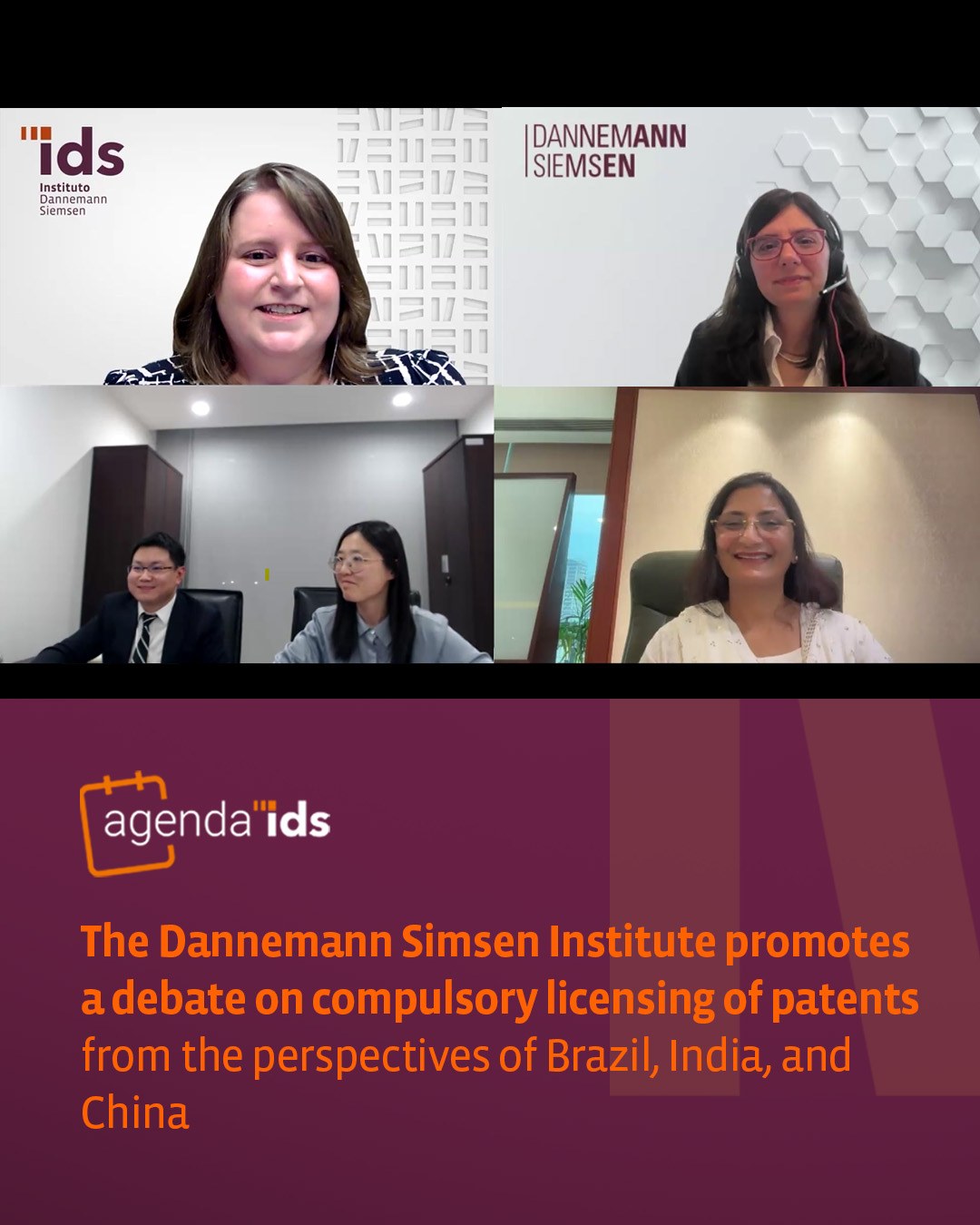13 de maio de 2025
Share
The Dannemann Simsen Institute promotes a debate on compulsory licensing of patents from the perspectives of Brazil, India, and China
On May 7th, the Dannemann Siemsen Institute (IDS) hosted another edition of the IDS Agenda, promoting an in-depth discussion on compulsory patent licensing from the BRICS countries’ perspectives, with a special focus on Brazil, China, and India. The event was opened by Patrícia Porto, IDS Academic Coordinator, and moderated by Ana Cláudia Mamede Carneiro, IDS Partner, who led the panel composed of Mamta Rani Jha, an expert in patent litigation in India, and Chinese engineers Ning JIANG and Butian MA, also specialized in patents. The discussion ranged from the legal foundations and procedures established in national legislation for declaring a compulsory license to practical examples, judicial decisions, and criteria for defining royalties, highlighting the particularities and convergences between the legal systems of these countries.
The debate began with an overview of the Brazilian legal framework, focused on the Industrial Property Law (Law No. 9.279/96, Articles 68 to 74), complemented by Laws No. 14.200/2021 and No. 15.122/2024, which expanded the grounds for compulsory licensing, including cases of national emergency, public interest, and international trade retaliation. Ana Cláudia explained that the Brazilian National Institute of Industrial Property (INPI) is the competent authority for granting compulsory licenses, although in emergencies, the federal government can act ex officio.
Next, Ning JIANG detailed the Chinese legal framework, noting that provisions for compulsory licensing have been in place since 1984, with updates in subsequent Patent Law revisions. Currently, eleven articles (53 to 63) regulate the topic, covering scenarios such as lack of adequate exploitation, monopolistic behavior, national emergencies, public interest, public health, and technological dependency.
Mamta Rani Jha presented the Indian experience, emphasizing that compulsory licensing in the country is governed by Chapter 16 of the Patents Act of 1970. In India, a compulsory license can be requested three years after the patent grant, provided that a prior attempt to obtain a voluntary license has been made. The main grounds include unmet public needs, excessive pricing, and lack of local exploitation. The government may also grant licenses in cases of national emergencies, extreme urgency, or pandemics, including for exporting medicines to developing countries.
Ana Cláudia resumed the discussion with examples from Brazil, emphasizing that the only effective case of compulsory licensing was the antiretroviral Efavirenz in 2007, under the National AIDS Program, after unsuccessful price negotiations. Other medicines had their prices renegotiated with pharmaceutical companies without needing to grant a compulsory license, highlighting the importance of balancing public interest with innovation.
Butian MA then presented cases from China, where, despite the lack of administrative compulsory licenses, court decisions have indirectly allowed third-party use of patented technologies initially exploited without authorization, provided that royalties are paid. One example involved an airport authorized to maintain patented facade connectors, prioritizing public interest and avoiding high replacement costs.
In India, only one compulsory license has been granted: in the Bayer vs. Union of India case, concerning the drug Nexavar, due to high pricing and limited accessibility. In three other cases, applications were denied for failing to meet legal criteria, such as lack of emergency, absence of a prior voluntary license attempt, or availability of alternatives, reflecting the strict application of the law to maintain a balance between innovation protection and access.
In the final segment, participants discussed how, in all three countries, patent holders dissatisfied with the granting of compulsory licenses or the arbitrated royalty amounts can appeal to the judiciary to challenge the decision.
Lastly, the speakers clarified that royalty rates vary by jurisdiction: in India, the rates range from 3% to 6%; in Brazil, from 1% to 7%; and in China, although no consolidated parameter exists for the pharmaceutical sector, court rulings have set amounts between 40,000 and 50,000 monetary units in strategic sectors.
Recordings will soon be available on the IDS website.
Note: For quick release, this English version is provided by automated translation without human review.
